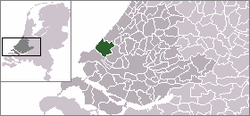
The House of Orange-Nassau is the current reigning house of the Netherlands. A branch of the European House of Nassau, the house has played a central role in the politics and government of the Netherlands and Europe especially since William the Silent organised the Dutch revolt against Spanish rule, which after the Eighty Years' War (1568–1648) led to an independent Dutch state.
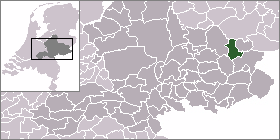
Borculo is a city in the eastern Netherlands, in the municipality of Berkelland, Gelderland. Borculo was an independent municipality until 2005, when it merged with Eibergen, Neede, and Ruurlo. Other population centers in the municipality of Borculo were nearby Geesteren, Gelselaar, and Haarlo.

Het Loo Palace is a palace in Apeldoorn, Netherlands, built by the House of Orange-Nassau.

Prince of Orange is a title originally associated with the sovereign Principality of Orange, in what is now southern France.

Frederick Henry was the sovereign prince of Orange and stadtholder of Holland, Zeeland, Utrecht, Guelders, Overijssel in the Dutch Republic from 1625 until his death in 1647. The last seven years of his life he also was the stadtholder of Groningen (1640-1647).

Amalia of Solms-Braunfels, was Princess consort of Orange by marriage to Frederick Henry, Prince of Orange. She acted as the political adviser of her spouse during his reign, and acted as his de facto deputy and regent during his infirmity from 1640–47. She also served as chair of the regency council during the minority of her grandson William III, Prince of Orange from 1650 until 1672. She was the daughter of count Johann Albrecht I of Solms-Braunfels (1563-1623) and countess Agnes of Sayn-Wittgenstein (1568-1617).

Catharina-Amalia, Princess of Orange, is the heir apparent to the throne of the Kingdom of the Netherlands, consisting of the constituent countries of Aruba, Curaçao, the Netherlands, and Sint Maarten.

Noordeinde Palace is one of the three official palaces of the Dutch royal family. Located in The Hague in the province of South Holland, it has been used as the official workplace of King Willem-Alexander since 2013.

Huis ten Bosch is a royal palace in The Hague, Netherlands. It is one of three official residences of the Dutch monarch; the two others being the Noordeinde Palace in The Hague and the Royal Palace in Amsterdam.

Princess Alexia of the Netherlands, Princess of Orange-Nassau is the second daughter of King Willem-Alexander and Queen Máxima. Princess Alexia is a member of the Dutch Royal House and second in the line of succession to the Dutch throne.

Drakensteyn Castle is a small castle at 8 Slotlaan in the hamlet of Lage Vuursche, in the municipality of Baarn, Netherlands. It is the private residence of Princess Beatrix of the Netherlands, the country's former Queen.

Hofwijck is a mansion built for 17th-century politician Constantijn Huygens. It is located in Voorburg on the Vliet canal from The Hague to Leiden. Formal address of the cultural heritage is 2 Westeinde, Voorburg, the Netherlands, but its location today is better known as the Voorburg railway station.
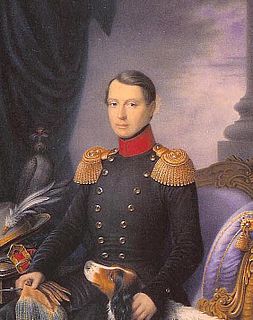
Prince Alexander of the Netherlands, Prince of Orange-Nassau was born at Soestdijk Palace, the second son to King William II of The Netherlands and Queen Anna Paulovna, daughter of Tsar Paul I of Russia. He was nicknamed Sasha within his family.
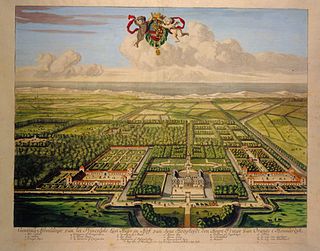
Huis Honselaarsdijk is a former palace and country residence of the Dutch Stadtholders and princes of Orange which lies about 2.6 km southwest of the border of The Hague, the Netherlands. It was one of the finest examples of Baroque architecture in The Netherlands. Today, only part of the outbuildings remain and are known locally as De Nederhof.

The monarchy of the Netherlands is a constitutional monarchy. As such, the role and position of the monarch are defined and limited by the Constitution of the Netherlands. Consequently, a large portion of it is devoted to the monarch; roughly a third of the document describes the succession, mechanisms of accession and abdication to the throne, the roles and responsibilities of the monarch and the formalities of communication between the States General and the role of the monarch in the creation of laws.
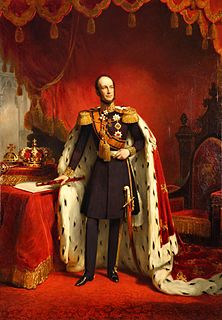
William II was King of the Netherlands, Grand Duke of Luxembourg, and Duke of Limburg.

Bartholomeus Corneliszoon van Bassen (1590–1652) was a Dutch Golden Age painter and architect.
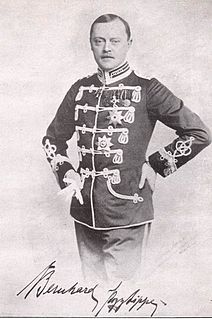
Prince Bernhard of Lippe was a member of the Lippe-Biesterfeld line of the House of Lippe. He was the father of Prince Bernhard of Lippe-Biesterfeld, the prince consort of Queen Juliana of the Netherlands.

De Akkermolen is a 17th-century windmill in Zundert, Netherlands. Built around 1605 to replace an earlier windmill, it was used as a gristmill until it was severely damaged in 1950. The mill was bought by the local government and restored in 1961, and it was listed as a national heritage site in 1974.

Sometimes jewellery used by the Dutch royal family are dubbed "crown jewels". In the past, the terms "House-diamonds", "House-jewels" and "family jewels" have been used. In 1790 the term "Bijoux de la Couronne" was used by Luise of Brunswick -Wolfenbüttel to refer to a large diamond from Borneo. In 1896 the Firm of van Kempen & Begeer wrote about resetting the jewels of the Crown. Queen Juliana gave a selection of her formal jewelry to the new Foundation Regalia of the House of Orange-Nassau, instituted on 27 July 1963. In 1968 a Foundation "Kroongoederen van het Huis van Oranje-Nassau" was instituted. It owns the regalia and the House-jewels.
